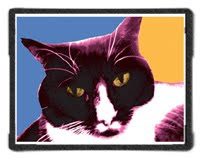Alloy and the General
The rapid approach of the Oscars reminds me (to my chagrin) that I've seen exactly one nominated film (Little Miss Sunshine). No different to any other year, really, and given that I only saw a half-dozen movies in a theater last year, I'm surprised that any of them got the nod from the little golden guy.
We could have rectified the situation this weekend by going to see The Departed, or The Queen, or Pan's Labyrinth, all of which are still playing in the area. But instead we went to the ICA to see an 80-year-old silent film with a live soundtrack of springs, horseshoes and musical saw.
The film was The General, Buster Keaton's 1927 masterpiece about a train engineer who steams through enemy lines during the Civil War to rescue his beloved engine (oh, and also the girl he loves). It's one of the best films I've ever seen: a tight, carefully constructed story with action, humor and breathtaking stunts that impress not only for their creativity and ingenuity, but also because they were executed way before wirework, stunt doubles or CGI.
In my favorite sequence, which really showcases Keaton's skills, his character, in pursuit of the enemy spies who have stolen his train, has to deal with an unwieldy cannon, a re-appearing boxcar and obstacles on the track--all while the train is moving. Here's a version of the scene, though the print quality isn't great and one of the gags has been edited out. Darn YouTube.
A great silent film needs a great soundtrack, and at the ICA this came courtesy of the Alloy Orchestra. Alloy is percussion-based; two-thirds of the group play drums, cymbals and "junk" (sheets of metal, springs, plus the aforementioned saw) as well as clarinet and accordion, while Mission of Burma vocalist Roger Miller's synth fills in with strings, brass, and everything in between.
I'd never seen a silent film with live music, and it brought a new, vibrant dimension to the experience. Maybe it was the insistent rhythm of the snare providing the clickety-clack voice of the speeding trains and the martial tattoo of the engaging armies, or the floor toms standing in for booming cannons, or the sheet of paper artfully crumpled to bring striking realism to an arson scene.
Or maybe it was watching these musicians as they played, eyes on the screen, moving effortlessly from one instrument to another, occasionally exchanging glances, dramatically flourishing drumsticks, rocking out old-school during exciting sequences.
When the film was over, and the audience had applauded both film and performers, the lights came up and the blackout screens over the floor-to-ceiling windows rose slowly, revealing the harbor and the skyline, and it was one of those moments to forget that Boston wasn't New York, that it was a world-class city with fabulous music and gorgeous architecture and the occasional sense to put the two things together with one of the best films ever made.
We could have rectified the situation this weekend by going to see The Departed, or The Queen, or Pan's Labyrinth, all of which are still playing in the area. But instead we went to the ICA to see an 80-year-old silent film with a live soundtrack of springs, horseshoes and musical saw.
The film was The General, Buster Keaton's 1927 masterpiece about a train engineer who steams through enemy lines during the Civil War to rescue his beloved engine (oh, and also the girl he loves). It's one of the best films I've ever seen: a tight, carefully constructed story with action, humor and breathtaking stunts that impress not only for their creativity and ingenuity, but also because they were executed way before wirework, stunt doubles or CGI.
In my favorite sequence, which really showcases Keaton's skills, his character, in pursuit of the enemy spies who have stolen his train, has to deal with an unwieldy cannon, a re-appearing boxcar and obstacles on the track--all while the train is moving. Here's a version of the scene, though the print quality isn't great and one of the gags has been edited out. Darn YouTube.
A great silent film needs a great soundtrack, and at the ICA this came courtesy of the Alloy Orchestra. Alloy is percussion-based; two-thirds of the group play drums, cymbals and "junk" (sheets of metal, springs, plus the aforementioned saw) as well as clarinet and accordion, while Mission of Burma vocalist Roger Miller's synth fills in with strings, brass, and everything in between.
I'd never seen a silent film with live music, and it brought a new, vibrant dimension to the experience. Maybe it was the insistent rhythm of the snare providing the clickety-clack voice of the speeding trains and the martial tattoo of the engaging armies, or the floor toms standing in for booming cannons, or the sheet of paper artfully crumpled to bring striking realism to an arson scene.
Or maybe it was watching these musicians as they played, eyes on the screen, moving effortlessly from one instrument to another, occasionally exchanging glances, dramatically flourishing drumsticks, rocking out old-school during exciting sequences.
When the film was over, and the audience had applauded both film and performers, the lights came up and the blackout screens over the floor-to-ceiling windows rose slowly, revealing the harbor and the skyline, and it was one of those moments to forget that Boston wasn't New York, that it was a world-class city with fabulous music and gorgeous architecture and the occasional sense to put the two things together with one of the best films ever made.
Labels: alloy orchestra, movies



0 Comments:
Post a Comment
Subscribe to Post Comments [Atom]
<< Home